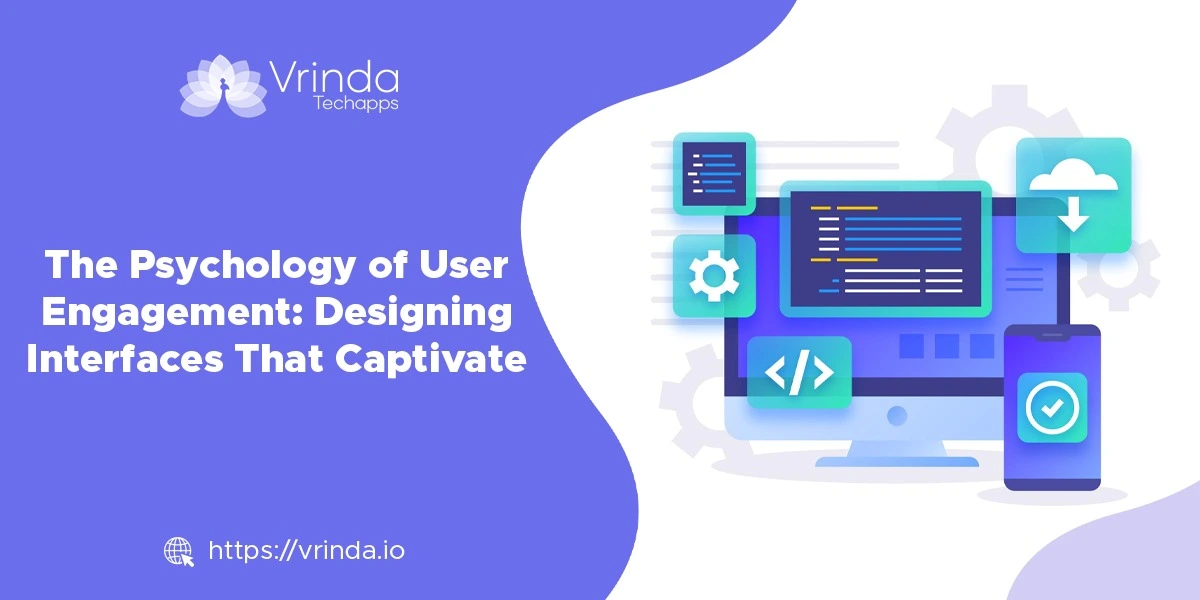
The Psychology of User Engagement: Designing Interfaces That Captivate
- September 21, 2023
- 13 min read
The omnipresence of screens has profoundly transformed our daily routines. Every swipe, click, and tap is a testament to businesses constantly vying for a sliver of our attention. It’s more than just crafting a visually appealing user interface (UI); it’s about architecting an experience that resonates with users at a psychological level. Mere aesthetics won’t cut it anymore.
Crafting such an impactful interface is an intricate dance of art and science, underpinned by a deep comprehension of user behaviors, desires, and motivations. Employing innovative design methodologies is imperative, but marrying them with an empathetic understanding of user psyche elevates a design from merely functional to truly transformative.
The Intricacies of User Psychology
At the heart of user engagement lies the complex matrix of human psychology. Users, consciously or subconsciously, seek interfaces that evoke a range of emotions, from trust and familiarity to excitement and curiosity. Factors like color theory, spatial arrangements, and even typography play pivotal roles in shaping these emotions.
For instance, blues and greens often convey a sense of trust and calmness, while reds can induce urgency or attention. Similarly, the way information is structured, whether hierarchical or linear, can dictate how easily a user processes that information. Simplified, user-friendly designs reduce cognitive load, ensuring that users don’t get overwhelmed and abandon the interface prematurely.
The Expertise of the Best UI UX Design Company
In a cutthroat digital world, the best UI UX design company stands out by mastering technical aspects and genuinely getting the pulse of human interactions and feelings. All the tiny details matter, for example, the placement of a button, the fluidity of an animation, or even the particular hue of a color. A well-informed and established service provider knows how a user feels and interacts.
Top-tier companies are always on their toes, tweaking and adjusting designs as they gather fresh feedback from users. They keep updating their designs always to match what their audience wants.
The Magic of Flutter in Bringing Designs to Life
Design, no matter how impeccable, remains theoretical until translated into a functional application. This is where tools like Flutter, a groundbreaking framework, step in. Through flutter app development services, businesses can transform intricate designs into fluid, responsive applications.
One of Flutter’s standout features is its ability to deliver a consistent user experience across a myriad of devices. In a world where users may switch between a smartphone, tablet, or desktop, this consistency can be the difference between a one-time visitor and a loyal user. Furthermore, Flutter’s widget-rich environment ensures that apps are not just functional but also delightful to interact with, further enhancing user engagement.
Strategies for Captivating User Engagement
When building a website or an app, the main goal is to create something users will love. But how? There are some top tips that expert designers swear by. By using these strategies, websites not only look good but also connect deeply with visitors. Read on to find out how top-notch design can make a big difference.
- Deep Personal Touch: Today’s savvy users yearn for platforms that echo their unique tastes and memories. It’s more than just presenting content—it’s about curating experiences. By molding suggestions or even design accents in tune with a user’s past behaviors, we create a space that feels truly theirs, naturally heightening their connection to it.
- The Joy of Gamified Experiences: Intertwining elements reminiscent of games—think enticing rewards, coveted badges, or motivating progress indicators—adds a delightful layer to the user’s journey. This approach taps into a deep-rooted human love for challenges and the sweet satisfaction of accomplishment.
- Valued Conversations: A nod of acknowledgment, virtual though it may be, in the form of a playful animation or a robust review mechanism, speaks volumes. It tells the user, “We see you. We value your input.” This recognition not only builds trust but also nurtures a sense of belonging and community spirit.
- The Elegance of Simplicity: In the vast world of design, embracing minimalism is akin to offering a breath of fresh air. By stripping away the noise and concentrating on the crux, we pave the way for a user to journey effortlessly, enjoying every moment of their immersive experience. Simplicity, done right, is truly captivating.
- Dynamic Interactivity: Beyond static designs lies a realm where elements spring to life. Be it the subtle dance of hover transitions, the tangible feel of drag-and-move features, or the thrill of witnessing real-time changes—interactive facets can transform user engagements from mere interactions to memorable events.
- Woven Tales of Consistency: A digital platform, in many ways, narrates a tale. And like any good story, consistency is key. By maintaining a harmonized design language, whether it’s the comforting familiarity of colors, the recognizable cadence of fonts, or the tone of communications, we wrap the user in a comforting blanket of trust and reliability.
- Evolution Through Learning: Imagine an interface that grows and refines itself, taking cues from every user interaction. By harnessing the power of machine learning, we’re not just reacting but foreseeing, making every interaction not just personal but also precognitive. It’s the art of meeting needs users themselves hadn’t yet recognized.
Overcoming Challenges in User Engagement
While the tools and strategies at our disposal are ever-evolving, so are the challenges. Today’s users have shorter attention spans, are more critical, and have a plethora of alternatives a click away. To ensure sustained engagement:
- Businesses must be proactive in identifying and rectifying pain points.
- Continual updates, in line with technological advancements and user feedback, are crucial.
- Regularly analyzing user metrics can provide invaluable insights into areas of improvement.
Conclusion
Designing interfaces that truly captivate users is a blend of art, science, and technology. As businesses vie for user attention, the role of a best UI UX design company becomes indispensable. By harnessing insights from user psychology, leveraging state-of-the-art tools like flutter app development services, and continually iterating based on feedback, businesses can craft interfaces that don’t just serve functional needs but also forge emotional connections.
In the dynamic world of digital interfaces, this holistic approach to design and development will separate the leaders from the followers.
Share this:
The Psychology of User Engagement: Designing Interfaces That Captivate
The omnipresence of screens has profoundly transformed our daily routines. Every swipe, click, and tap is a testament to businesses constantly vying for a sliver of our attention. It’s more than just crafting a visually appealing user interface (UI); it’s about architecting an experience that resonates with users at a psychological level. Mere aesthetics won’t cut it anymore.
Crafting such an impactful interface is an intricate dance of art and science, underpinned by a deep comprehension of user behaviors, desires, and motivations. Employing innovative design methodologies is imperative, but marrying them with an empathetic understanding of user psyche elevates a design from merely functional to truly transformative.
The Intricacies of User Psychology
At the heart of user engagement lies the complex matrix of human psychology. Users, consciously or subconsciously, seek interfaces that evoke a range of emotions, from trust and familiarity to excitement and curiosity. Factors like color theory, spatial arrangements, and even typography play pivotal roles in shaping these emotions.
For instance, blues and greens often convey a sense of trust and calmness, while reds can induce urgency or attention. Similarly, the way information is structured, whether hierarchical or linear, can dictate how easily a user processes that information. Simplified, user-friendly designs reduce cognitive load, ensuring that users don’t get overwhelmed and abandon the interface prematurely.
The Expertise of the Best UI UX Design Company
In a cutthroat digital world, the best UI UX design company stands out by mastering technical aspects and genuinely getting the pulse of human interactions and feelings. All the tiny details matter, for example, the placement of a button, the fluidity of an animation, or even the particular hue of a color. A well-informed and established service provider knows how a user feels and interacts.
Top-tier companies are always on their toes, tweaking and adjusting designs as they gather fresh feedback from users. They keep updating their designs always to match what their audience wants.
The Magic of Flutter in Bringing Designs to Life
Design, no matter how impeccable, remains theoretical until translated into a functional application. This is where tools like Flutter, a groundbreaking framework, step in. Through flutter app development services, businesses can transform intricate designs into fluid, responsive applications.
One of Flutter’s standout features is its ability to deliver a consistent user experience across a myriad of devices. In a world where users may switch between a smartphone, tablet, or desktop, this consistency can be the difference between a one-time visitor and a loyal user. Furthermore, Flutter’s widget-rich environment ensures that apps are not just functional but also delightful to interact with, further enhancing user engagement.
Strategies for Captivating User Engagement
When building a website or an app, the main goal is to create something users will love. But how? There are some top tips that expert designers swear by. By using these strategies, websites not only look good but also connect deeply with visitors. Read on to find out how top-notch design can make a big difference.
- Deep Personal Touch: Today’s savvy users yearn for platforms that echo their unique tastes and memories. It’s more than just presenting content—it’s about curating experiences. By molding suggestions or even design accents in tune with a user’s past behaviors, we create a space that feels truly theirs, naturally heightening their connection to it.
- The Joy of Gamified Experiences: Intertwining elements reminiscent of games—think enticing rewards, coveted badges, or motivating progress indicators—adds a delightful layer to the user’s journey. This approach taps into a deep-rooted human love for challenges and the sweet satisfaction of accomplishment.
- Valued Conversations: A nod of acknowledgment, virtual though it may be, in the form of a playful animation or a robust review mechanism, speaks volumes. It tells the user, “We see you. We value your input.” This recognition not only builds trust but also nurtures a sense of belonging and community spirit.
- The Elegance of Simplicity: In the vast world of design, embracing minimalism is akin to offering a breath of fresh air. By stripping away the noise and concentrating on the crux, we pave the way for a user to journey effortlessly, enjoying every moment of their immersive experience. Simplicity, done right, is truly captivating.
- Dynamic Interactivity: Beyond static designs lies a realm where elements spring to life. Be it the subtle dance of hover transitions, the tangible feel of drag-and-move features, or the thrill of witnessing real-time changes—interactive facets can transform user engagements from mere interactions to memorable events.
- Woven Tales of Consistency: A digital platform, in many ways, narrates a tale. And like any good story, consistency is key. By maintaining a harmonized design language, whether it’s the comforting familiarity of colors, the recognizable cadence of fonts, or the tone of communications, we wrap the user in a comforting blanket of trust and reliability.
- Evolution Through Learning: Imagine an interface that grows and refines itself, taking cues from every user interaction. By harnessing the power of machine learning, we’re not just reacting but foreseeing, making every interaction not just personal but also precognitive. It’s the art of meeting needs users themselves hadn’t yet recognized.
Overcoming Challenges in User Engagement
While the tools and strategies at our disposal are ever-evolving, so are the challenges. Today’s users have shorter attention spans, are more critical, and have a plethora of alternatives a click away. To ensure sustained engagement:
- Businesses must be proactive in identifying and rectifying pain points.
- Continual updates, in line with technological advancements and user feedback, are crucial.
- Regularly analyzing user metrics can provide invaluable insights into areas of improvement.
Conclusion
Designing interfaces that truly captivate users is a blend of art, science, and technology. As businesses vie for user attention, the role of a best UI UX design company becomes indispensable. By harnessing insights from user psychology, leveraging state-of-the-art tools like flutter app development services, and continually iterating based on feedback, businesses can craft interfaces that don’t just serve functional needs but also forge emotional connections.
In the dynamic world of digital interfaces, this holistic approach to design and development will separate the leaders from the followers.
RELATED ARTICLES
10 Fundamental User Experience (UX) Design Principles Every Designer Should Know in 2025
Explore presenting a treasure map to someone with the ‘X’ scrawled in invisible ink. In our fast-paced environment, that is how a digital product without excellent UX design seems.
Why Businesses in Hyderabad Are Choosing ERPNext: A Game-Changer for Growth
Hyderabad’s business scene? It’s a storm. One moment, ideas are sketched on cafe napkins; the next, scaling teams becomes the challenge. Spreadsheets multiply, invoices chase, and businesses can feel like they’re being steered, not steering.
How a UI/UX Design Company in Florida Can Elevate Your Digital Presence
Let’s be honest: your website or app shouldn’t be boring in the current world where everyone is glued to their devices. You wouldn’t bring someone to a party without music and a broken dance floor, would you? The same goes for your digital space. It’s the initial impression you give.



